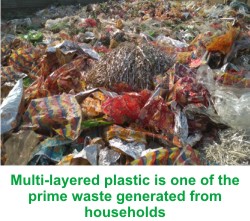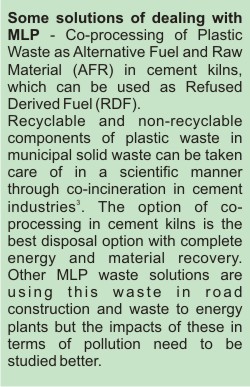|
Energy Recovery from Multi-Layered Plastic Waste
Has
anyone ever wondered what happens to the wrapper of a biscuit packet,
chips, shampoo pouches and other multilayer plastic packing (MLP) once
you discard them? All these go to landfills which have massive quantum
of plastic and MLP waste. As per an estimation, if the current
consumption patterns and waste management practices do not improve, by
2050 there will be about 12 billion tonnes of plastic litter in
landfills (new UN report released on June 5, World Environment Day 20181). Multi-layered plastic is one of the prime waste streams generated from the households both in urban and semi-urban areas. With increasing affluence and purchase power, the use of packaged products has increased exponentially. This has led to increase in the quantities of multi-layered plastic. Presently this is being disposed of through unsustainable means resulting in land filling or open burning. Unorganised dumping creates numerous adverse effects in the environment such as clogging of drainage systems and water sources. Long time exposure in the open atmosphere produces poisonous leachate resulting in polluting the water streams and the soil. The government also does not have a clue how to deal with these packets which take years to decompose and add to garbage dumps. According to the Central Pollution Control Board, the space required for land filling is increasing day by day. Delhi Okhla landfill site exhausted in 2010. Bhalswa landfill exhausted in 2007. This is only one city’s example but this is happening in other municipal locations as well.
As per the recent legislations, the
responsibility of managing such waste is upon companies under the
concept of Extended Producer Responsibility and legislation defined by
the Indian Ministry of Environment and The industry has been aided by the government’s lackadaisical attitude. In 2016, the government passed the Plastic Waste Management Rules that mandated phasing out ‘non-recyclable multilayered plastic’ in two years. But on March 27, 2018, it amended them and ‘non-recyclable multilayered plastic’ was substituted with ‘multi-layered plastic which is non-recyclable or non-energy recoverable or with no alternate use’. This gave producers an escape route by claiming that the packaging material, if not recycled, can be put to some other use. MLP manufacturers used this loophole to continue to use the material. The 2016 rules also mandated companies to practice EPR and collect MLP that they have used to package their products. But the rules did not clearly mandate anywhere a minimum percentage of the waste they must retrieve.
According to the latest report on the
Implementation of Plastic Waste Management Rules published in 2016, the
plastic waste generated across the country is close to 1.6 million
tonnes a year, with almost half of it coming from Maharashtra and
Gujarat2. Moreover, manufacturers believe that they cannot survive without MLP, because MLP can survive where temperatures reach 50°C. The government needs to frame a comprehensive EPR policy with clear responsibilities of all stakeholders throughout the lifecycle of MLP. Initiatives, like deposit-and-return schemes or advanced disposal fee, should be enforced. It is also necessary to bring the informal sector into the mainstream of MLP waste management. ■
Ganesh Kumar References 1. https://www.efe.com/efe/ english/ portada/un-warns-globally-only-9-percent-of-plastic-waste-is-recycled/50000260-3638548 2. https://www.downtoearth.org.in/news/ waste/breaching-the-threshold-60748 3. http:www.ijrdet.com/files.Volume4Issue5/ IJRDET_0515_03.pdf
|

 Forest in 2016 in the form of Plastic Waste Management and Handling
Rules.
Forest in 2016 in the form of Plastic Waste Management and Handling
Rules.